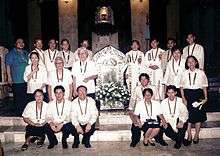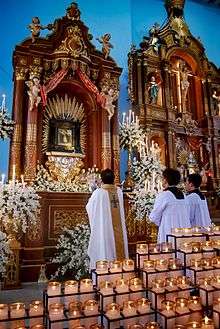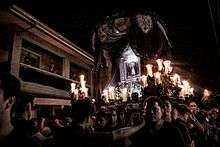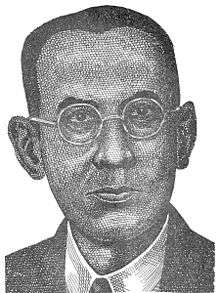Our Lady of Porta Vaga
| Our Lady of Solitude of Porta Vaga Nuestra Señora de la Soledad de Porta Vaga Birhen ng soledad ng Porta Vaga | |
|---|---|
|
Original Bejeweld Painting of Our Lady of Solitude of Porta Vaga | |
| Luz de Filipinas, Reina de Cavite, La Celestial Guardiana y Protectora de la Provincia de Cavite y su Puerto, La Excelsa Patrona de la Ciudad y Provincia de Cavite | |
| Venerated in |
Roman Catholic Church Philippine Independent Church |
| Major shrine |
San Roque Church, Cavite City, |
| Feast | 2nd and 3rd Sunday of November |
| Attributes |
Oil painting on canvas Aureola with 24 stars made from diamonds Rosary, beads made from pearls and the Cross of diamonds, The Crown of Thorns and Nails symbols of Chist Passion gold and silver Riza in the shape of candle sticks, angels, curtains, and shells Silver and Kamagong Frame |
| Patronage | Province of Cavite, Cavite City Patroness of Galleons, Seafarers, Caviteño people |
Our Lady of Solitude of Porta Vaga (Spanish: Nuestra Señora de la Soledad de Porta Vaga), or commonly Our Lady of Porta Vaga, is the Patroness of the Cavite province in the Philippines.
The icon, which depicts the Virgin Mary as Our Lady of Solitude, is enshrined at San Roque Church in Cavite City. The devotion to Our Lady of Porta Vaga is one of the famous Marian devotions in the Philippines.[1]
Titles
The icon has received several titles in its history, including "Queen of Cavite" and "Exalted Patroness and the Celestial Guardian and Protectress of the Province of Cavite and its Port" (Spanish: "Reina de Cavite", "La Excelsa Patrona y La Celestial Guardiana y Protectora de la Provincia de Cavite y su Puerto"). .
The icon was used to bless departing trade galleons plying the route between Cavite and Acapulco, Mexico, earning her the title "Patroness of the Galleons", while stories of its miraculous powers thus earned it the title, "The Virgin of Thousand Miracles".
Description
The Blessed Virgin Mary is depicted as garbed in black and white, kneeling as she contemplates the instruments of her Son's Passion. Before her are the crown of thorns and the nails.[2] The icon is painted on a canvas framed in carved wood. The painting itself is set in gold and silver accouterments with precious gems that are ex votos from her devotees.
An inscription found at the back of the painting says:
"A doze de Abril 1692 años Juan Oliba puso esta Stma. Ymagen Haqui"
("On 12 of April 1692, Juan Oliba placed this most holy image here")
. It is considered an invaluable treasure inherited by the Caviteños, and is the oldest extant dated Marian painting in the Philippines.
History
A legend narrates that during the Spanish colonial era, at the peak of Cavite's economic prosperity because of the Manila-Acapulco Galleon Trade, a small detachment of the Spanish Guardia Civil was stationed at a garita (little garrison, or sentry post) located at the Vaga Gate of the Cavite Port, at the end of the isthmus separating it from Barrio San Roque.
One stormy night, a Spanish sentinel was at his post when he saw a bright, shifting light. A dazzling apparition rose from the currents of Cañacao Bay and startling the sentry, who surmised that the light came from pirates out to raid the port.

Frightened, the sentinel shouted,
"¡Alto! ¡Alto!"
("Halt! Halt!").
Instead of stopping, the light went towards him. Hence, in a loud voice he asked,
"¿Quién vive?"
("Who is there?").
He then heard a sweet and melodious voice reply,
"Soldadito, ¿por qué el alto me das en noche tan fría? Dame paso. ¿No conoces a María?"
("Little Soldier, why halt me on a night so cold? Give me passage. You do not recognise Mary?")
The awestruck and confused sentinel humbly repented.
"Perdóname, Virgen María, Reina de mi devoción; pues solo soy un soldado que cumplo mi obligación!"
("Forgive me, Virgin Mary, Queen of my devotion; for I am but a soldier that complieth with my duty!")
The following morning, fisherman and workers at the Cavite Royal Arsenal passed through the Vaga Gate and found a framed image of the Virgin on the beach along Cañacao Bay, near the place of her apparition the night before. They brought the painting to the parish priest, who temporarily installed it in the parish church. Eventually, the Ermita de Porta Vaga (Chapel of Vaga Gate) was built along the port's walls, and for three centuries served as the shrine of Our Lady of Solitude.
In 1929, a new parish priest, Fr. Pedro Lerena y Lerena of Logroño, Spain, was assigned to the Cavite Port. At the same time, he was appointed Rector of the Ermita. His great dedication to the cause of Our Lady of Porta Vaga saw the beautification and the improvement of the Ermita through the years.
During the Second World War, Fr. Lerena rescued the icon from a junkyard that the Imperial Japanese Army had thrown it in. The image first stayed in the Arzobispado (Archbishop's Palace) in Intramuros before it was deposited in the vaults of the Philippine National Bank for safekeeping.
The icon returned to Cavite after the Allied liberation of the islands in 1945, re-enshrined at its home in the San Roque Church because the Ermita was destroyed by bombardment during the war. Fr. Lerena served as the icon's guardian until his death in 1972.

Coronation
Through the joint efforts of Msgr. Baraquiel Mojica, former parish priest of San Roque, and Bishop Felix Pérez of the Diocese of Imus, the miraculous icon was canonically crowned on November 17, 1978 by Apostolic Nuncio to the Philippines, Bruno Torpigliani, D.D., during the reign of St. John Paul II- the first Philippine Marian image crowned during his pontificate. The existence of a papal bull for the coronation is disputed, as no records of Pontifical authorization to crown the image also exist in Rome. Nevertheless, a Pontifical High Mass was offered in her honour at Binondo Church in Manila, followed by a concert featuring the works of the National Artist Lucio San Pedro. Devotion to the image gave the Caviteños the opportunity to show their art skills.
Theft and return
On March 16, 1984, the icon of the Virgin was sacrilegiously stolen from its altar. After tedious months of search, it was recovered on the Feast of the Assumption, August 15, 1984, albeit divested of all its original gilding and precious stones. Every effort was made by devotees to restore the image to its former glory, and on August 19, 1984, it was re-enshrined in the altar amidst much rejoicing.[3]
The Confraternity of the Virgin of Solitude of Porta Vaga

By decree of then Imus Bishop, Most Rev. Manuel C. Sobrevinias, the Cofradia de la Virgen de la Soledad de Porta Vaga was founded in August 10, 1998. The group was officially inaugurated in November 17, 1998 as a gift to the Virgin of Solitude on the 20th Anniversary of Her Coronation by then Apostolic Nuncio, Bruno Topigliani. It was led by the late Antonio G. Nazareno as its Founding President, Rev. Fr. Virgilio Saenz Mendoza as its Spiritual Director and Rev. Fr. John Brillantes as its Spiritual Adviser.
Since then, the Cofradia de la Virgen de la Soledad de Porta Vaga has led numerous devotees of the Virgen de la Soledad in the strengthening and greater propagation of more than three centuries of ardent filial devotion to Her. She has truly invaded the hearts of many devotees as the group brought Her into various homes and shrines in and out of the country.
The Cofradia de la Virgen de la Soledad de Porta Vaga, presently led by Rev. Fr. Virgilio Saenz Mendoza and Jonnell Ryan I. Enriquez, heads the devotees of Our Lady.
Miracles
Countless miracles have been attributed to the Virgen de la Soledad. Her mysterious apparition and the unexplained arrival of her image were initial revelations of her miraculous reign.
Fire at the Ermita de Porta Vaga
During the terrible typhoon in 1830, a fire caused by lightning bolt hit the wooden altar of the Ermita and razed the chapel to the ground, but the image of the Virgin remained intact among the ashes.
1856 typhoon
In 1856, another terrible typhoon flooded the houses, churches and public buildings within the Port but the Ermita, as well as its patio were found dry so the people took refuge in the Church. In 1857,
Spanish frigate Lucero
On June 30, 1857, a Spanish frigate based in Cavite and named “Lucero” was caught by a violent typhoon off the coast of Albay. It ran aground on the rocky place known as Rawis, legaspi. For twenty two days, the ship was unable to move not only because of the low tide, but also because of the absence of even a slight breeze. The crewmen were worried because their provision was running low. It happened that one of the crew members was a devotee of the Virgen de la Soledad. He took out Her picture and asked his fellow sailors to pray before Her. One night, the Virgin appeared before the crewmen in the light of the pale moon. As they fell to their knees, the tide rose higher and higher and the wind began to blow. The frigate floated free from its rocky trap and was able to return safely to Cavite. There was so much jubilation. As the crewmen set foot on the ground, they proceeded right away to the Ermita. There, to the tune of the Te Deum, they expressed their gratitude to the Virgin.
1882 cholera epidemic
In 1882, a terrible cholera epidemic spread in Cavite Puerto.It was said that Caviteños died by the hundreds and the streets had been a scene of daily funeral processions. The Spanish politico-military governor of Cavite, Don Juan Salcedo Y Mantilla de los Rios, ordered the spraying and burning of gunpowders on the streets so that the fire and the smoke they produce might drive away the virus of the disease.By mid-October, the epidemic was placed under control.
During this epidemic, the Governor himself fell ill.One afternoon, as he was about to take his siesta, he ordered his soldiers not to admit any visitor.After some time, he heard a persistent knock at the door. To his surprise, he found an old woman dressed in black. After the customary greetings, she asked him to give orders that the fiesta of Cavite be celebrated with the greatest pomp possible.
The Governor, eager to send the intruder away, agreed to the request. Then, the unwanted visitor left.The Governor, filled with fury at his soldiers, reprimanded them for admitting the old lady. The guards replied that they had not allowed anyone to enter the house. Then the Governor remembered the request. He realized that it must be the Virgin Herself who appeared to him.He also realized that after talking to the woman, the fever had left him.
- All these miracles were depicted on large canvasses painted by Don Roman Faustino, Cavite’s most celebrated painter and pupil of Juan Luna,.These paintings were complete with the details and the respective dates of the miracles. Once, they were hanged on the walls of the Ermita. Everything perished during the last world war as if to signify that these miracles do not belong to the physical realm of life. More important perhaps than these human attempts to share with the future is the message of Cavite’s Patroness to Her fold:
“I am thy Mother. Honor me. I shall always be with you all.”
- There have been other miracles attributed to the Virgin with the passing of the years including present day accounts of healings, families reunited and family problems solved.
Devotion

Our Lady of Solitude of Porta Vaga is one of the most venerated Marian images in Cavite. Her feast is celebrated every second and third Sunday of November in Cavite City. She is also associated with annual Lenten rites and the All Saints-All Souls Day observances where she is alluded to in Tagalog as "Ináng Mágkakandila" (Mother Candlemaker). The image celebrated the Pearl Jubilee of its coronation 2008 and the Silver Jubilee of its return the following year.
Devotees include Overseas Filipino Workers and other foreign nationals who flock to the country to join the Porta Vaga Festival.
Replicas of the Ynang Nag-Iisa ("Ináng Nag-iisá" in modern Tagalog), are also venerated in San Isidro, Nueva Ecija; Camba in Tondo, Manila; San Carlos, Pangasinan and Buhi, Camarines Sur.
- The Nuestra Señora de la Soledad of San Isidro Labrador Parish Church in San Isidro, Nueva Ecija
 Nuestra Señora de la Soledad de Manila, Camba, Tondo, Manila
Nuestra Señora de la Soledad de Manila, Camba, Tondo, Manila Soledad of Buhi, Camarines Sur
Soledad of Buhi, Camarines Sur
An estampa of the Virgen de la Soledad is venerated at the chapel of “Tahanan ng Mabuting Pastol”,the Diocesan Seminary for Cavite. This image was formerly hung at the Hesuit college of Cavite. After the expulsion of the Jesuits in 1768, the image was kept in the Jesuit archives of Ateneo. The image was given to Bishop Perez as a gift on the occasion of the inauguration of the new seminary. On this estampa, an inscription says that the Spanish Archbishop of Manila, Don Basilio Sancho de Sta. Justa y Rufina granted 80 days indulgence for those who would say the novena in Her honor. Bishop Mateo Rubio de Arevalo of Cebu granted 40 more days for those who did likewise. Another Archbishop, Don Juan Antonio de Obrigo y Gallego granted indulgence to Her devotees.
Novena
To this day, it is not known when the novena for Her was written and who wrote it. According to Mr.Ricky Jose, some of its prayers may have been taken from a little booklet published in 1742 entitled “Soledad patrocinante de Maria. Oracion evangelica de Nuestra Señora de la Soledad, appelida de la Puerta Vaga”; this was a printing of a prayer or discourse preached in 1741 by the Dominican Fr. Juan de la Cruz, historian of his order and a missionary in China.
In the nineteenth century, a Tagalog translation of this Novena was made by Fr. Juan Dilag, a chaplain of the Ermita. On August 31, 1861, Don Candido Ureta de Manzares, the chancellor of the Archdiocese of Manila approved the Tagalog translation.
Don Candido Ureta Manzanares, Priest, Doctor of Sacred Theology, Commander of the Royal and Distinguished Spanish Order of Carlos III, Canon of the Holy Cathedral Church, and Secretary of Government House and the Archbishop, etc., certify that, at the request of Fr. Juan Dilag in application for license to print the manuscript entitled in Tagalog: “Pagsisiyam sa mapagpalang Ina, na ang pamagat Nuestra Senora de la Soledad.” S.E.I. has served decree on this date the following:
We attach herewith to act as license to print in the Tagalog language manuscript entitled ‘Pagsisiyam sa mapagpalang Ina, na ang pamagat Nuestra Senora de la Soledad.’, in response to that as reported by the Censor that our Order has examined such, not contain anything against the dogma and morality, but rather deemed highly desirable for the pious reading of the faithful. Recorded for the Secretariat in testimony of this decree and filed the original subject.— Archbishop Gregory
Procesión del Silencio (Procession of Silence)

To conclude with the celebrations of Good Friday, devotees of the Virgen de la Soledad come out after the traditional Santo Sepulcro Procession for a time of profound penance and prayer for the Procession del Silencio de la Virgen de la Soledad. Devotees, mostly clad in black, barefoot and silently praying with their candles in hand, accompany the age-old icon of the Virgen de la Soledad on a short route to symbolize the Virgin's lonely walk back home after bringing Christ's body to the Holy Sepulchre. This procession brings out the grief we believers have in giving consolation to our Lady in Her time of bereavement. As we can remember, the icon of the Virgen de la Soledad is a depiction of the Blessed Virgin Mary on the night of the first Good Friday, where She spent time alone in solitude, in quiet prayer and meditation, pondering over the great sufferings that Her Son has endured. By joining Her in this journey, we are also consoled with the fact that Mary is always present in our daily struggles in life.
First Saturday Devotion
The First Saturdays Devotion (or Act of Reparation to the Immaculate Heart of Blessed Virgin Mary) is a Catholic practice which, according to the visionaries, has been requested by the Blessed Virgin Mary in several visitations, notably Our Lady of Fatima and the subsequent Pontevedra apparitions. This devotion, and the marian apparitions, have been officially embraced by the Roman Catholic Church.
The devotion fits on the Catholic tradition to venerate the Virgin Mary particularly on Saturdays, which originated in the scriptural account that, as the Mother of Jesus Christ, her heart was to be pierced with a sword, as prophesied during the presentation of Jesus in the temple; such sword was the bitter sorrow during the Crucifixion of Jesus (which Catholic devotees understand as the union of the Immaculate Heart of Mary and the Sacred Heart of Jesus). Such sorrow is particularly bitterly endured on Holy Saturday after Jesus was placed on the Sepulcher (before the Resurrection on Easter). Devotees of Fátima believe that the First Saturdays help to console the sorrows of the Lord Jesus and the Virgin Mary for the sins against Her Immaculate Heart.
In the Shrine of the Virgen de la Soledad, this devotion is being observed through a simple yet profound activity. Every first Saturday of the month, the original icon is being exposed for veneration beginning with a Rosary and Novena at 11:00 in the morning, followed by a "Misa de la Reina". The monthly meeting and general assembly of the Cofradia de la Virgen de la Soledad de Porta Vaga follows to discuss activities uplifting the devotion to the Reina de Cavite. Everyone is invited to attend.
Hymn

In 1892, Julian Felipe, composer of the Philippine national anthem, penned the hymn "Reina de Cavite" on the occasion of her fiesta and the opening of the Exposición Regionál Caviteña (Cavite Regional Exposition).. The lyrics were taken from the poem Himno a la Virgén de Cavite (Hymn to the Virgin of Cavite) by Fr. Tomás de Andrade, the rector of the Jesuit College of Cavite sometime in 1689.[4][5]
|
Original Poem By |
Lyrics used by Julian Felipe |
Reyna ng Kabite |
|---|---|---|
|
Reina de Cavite La nacion entera Como la heroina Madre immaculada |
Reina de Cavite Reina de Cavite Madre Immaculada, Madre Immaculada, Luz de Filipinas, |
Reyna ng Kabite Reyna ng Kabite Inang kalinis-linisan Inang kalinis-linisan Ilaw ka ng Pilipinas |
| Wikimedia Commons has media related to Our Lady of Porta Vaga. |
See also
References
- ↑ Aluit, Alphonso J. (1969). "The Galleon Guide to Philippine Festivals", p. 97. SIN B004CWODBO.
- ↑ Panlilio, Erlinda Enriquez (2003). "Consuming passions: Philippine collectibles", pg. 70. Jaime C. Laya. ISBN 9712714004.
- ↑ Mendoza, Fr. Virgilio. Cavite: Cultura E Historia (First ed.).
On August 19, 1984, the celebration of the feast of San Roque was coincided with the blessing of the replica of the Virgen de la Soledad. Secretly, it was also the day set for the announcement of the recovery of the Virgin. At nine in the morning, the mass for the solemn blessing of the replica started. After the gospel, the Bishop of Imus blessed the new image. Then to the great surprise of the faithful, the stolen image was presented to them, divested of its former glory.
- ↑ Romanillos, Emmanuel Luis A. (2006). "Chabacano studies: essays on Cavite's Chabacano language and literature", pg. 125. Cavite Historical Society.
- ↑ Delos Reyes, Aloma Monte (1994). "Sto. Niǹo de Molino Bacoor, Canite 1984-1994: the making of a parish", pg. 139. Parish of Sto. Nino de Molino, Bacoor, Cavite.
Other references
- Barcelona, Mary Anne. Ynang Maria: A Celebration of the Blessed Virgin Mary in the Philippines. Edited by Consuelo B. Estepa, P.D. Pasig City: Anvil Publishing, Inc., 2004.
- Cavite Studies Center-De La Salle University Dasmariñas. CAVITE Cultura e Historia. Edited by Teresita P. Unabia and Victor Immanuel R. Cuarto. Cavite: Cavite Historical Society, Inc., 2002.
- Almanaque de N.S. del rosario, 1946, p. 284.
- Archdiocesan Archives of Manila: (Document Nos. 92 LGE1C9 1751-1752A; 109-10, LGE 1010 1767-1771; 182, LGE 1 C 8 - 1750 1742 A; 250, LGE 1 C 9 - 1747 1756; 294, LGE 1 C 9 - 1751-1752 A; 321, LGE 1 C 8 - 1737 1742; 436, Libro del Govierno Ecclesiastico 1 C 8 1737 - 1750; SV4A1 1805 - 1806 A; 475, 522, 960 LGE 1010 1767 - 1771; and 20 S V 4aL 1786 - 87 B)
- Avellanedad, Miguel. Catologo de Los Religiosos de la Orden Agustinos Recoletos, 1606-1636.
- Don Gervacio Pangilinan. Historica de Cavite, mss.
- Aviado, Lutgarda. Madona of the Philippines. [n.imp.]
- Braganza, Jose Vicente, SVD. Early Church History of Cavite: Dominicans, Recoletos and Filipino Secular Clergy. DIWA Studies in Philosophy and Theology. Vol. VIII No. 1, Tagaytay City: Graduate School of Divine Word Seminary.
- Jose, Regalado Trota, The Eight Churches of Cavite Puerto (1586-1900). Philippine Quarterly of culture and Society. 1987.
- Fernandez, Antonio J., Algunos Milagros Hechos Por Nuestra Señora, La Virgen de la Soledad de Porta Vaga- Patronas del Pueblo de Cavite. Programas de las Fiestas Generales de Cavite, 1932, pp. 11–15.
- German, Alfredo, Our Lady of Solitude: Facts and Legend". Souvenir Program Cavite Fiesta, 1964.
- Nuestra Señora de la Soledad: The Mystical Madonna of Camba. The Manila Digest, Vol. 2, No.3, Manila: Archdiocese of Manila, April 1990. pp. 11–12.
- Samonte, Godofredo, Odyssey of the Virgin. Souvenir Program Cavite Fiesta, 1964.
- San Agustin, Narciso La Tradicional Fiesta de Cavite. Souvenir Program, Cavite Fiesta, 1949.

